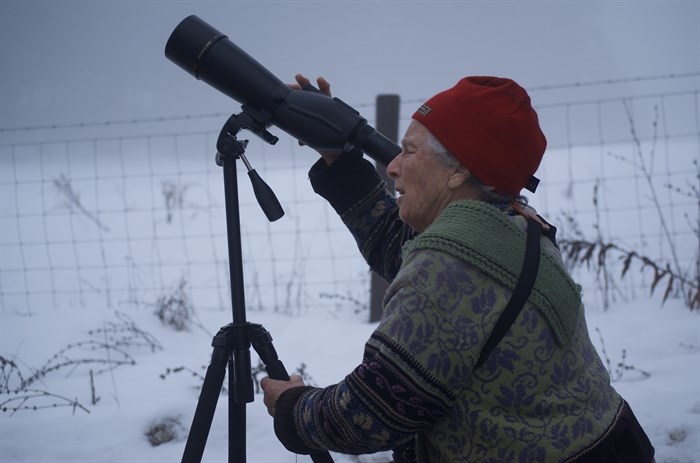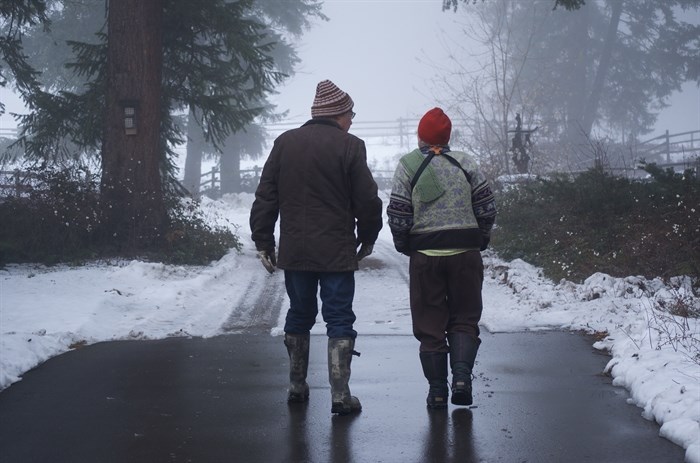
Joyce Henderson is a member of the Shuswap Naturalist Club who has been participating in the annual Christmas Bird Count for many years.
(CHARLOTTE HELSTON - REPORTER / iNFOnews.ca)
January 01, 2020 - 12:30 PM
Three women take slow, tentative steps through the snow. It’s a perfectly still December morning, just after daybreak. With a single gesture from the leader — a firm hand outstretched behind her — the procession comes to a halt. Joyce Henderson, the leader, cocks her head to the side, listening. Briefly, she shuts her eyes in concentration. A jubilant trill rings out from the tangle of brush.
“Chickadee,” she announces.
The small, plump-bellied bird with its distinguished black-capped head is no rare or unusual find. It is a common visitor at backyard bird feeders and found in the repertoire of most birders and non-birders alike. But today, this humble chickadee will be one of millions of birds fastidiously counted and recorded by birding enthusiasts across the Okanagan — and North America — as part of the annual Audubon Christmas Bird Count.
Henderson is joined by fellow birders Dorothy Parks and Marie Fortin. Each wears a pair of binoculars around their necks, and as the designated recorder, Parks also carries a tally sheet. The women joke that their silent, early morning creeping along back roads and into back yards, binoculars at the ready, can sometimes give the wrong impression. Throughout the day, however, local residents seem only too pleased to see the group and invite them into their yards. Many treat the visit as a chance to share intel, get help identifying birds and just chit-chat about a shared passion for wildlife. Despite the importance of keeping quiet, it’s really quite a social event.
“I’m one of the yackers,” Parks says with a chuckle. “She (Henderson) is always shushing us.”
Henderson, Parks and Fortin are one of six teams, and roughly two dozen volunteers overall, covering a 24 km diameter area in the Shuswap. Today’s count will take the trio to several backyard birding hotspots — places where residents dutifully keep feeders filled — as well as more surprising places like the local dump. Meanwhile, hundreds of other volunteers will be conducting counts in hundreds of other circles across the country. These counts occur over the span of a single day falling between the dates of Dec. 14 and Jan. 5. The results are shared with Bird Studies Canada, which then sends the data to the Audubon Society. The Christmas Bird Count — commonly referred to by birders as ‘the CBC’ — began 120 years ago. According to the Audubon Society, the annual event was created in response to a former, longstanding tradition in which hunters competed to bring in the the biggest pile of birds, and other animals. On Christmas Day 1900, ornithologist Frank M. Chapman initiated the first Christmas Bird Census in an effort to count, not kill, birds over the holidays. The event grew into one of the largest and longest-running citizen science efforts in the world.
“It’s important to collect data over a long period of time so you can see trends in different species of birds,” Henderson says.
Indeed, the results of the Christmas Bird Count have long been used in major studies chronicling the changing landscape of bird populations in North America. You may have heard about a recent report that found bird populations have declined by an alarming three billion in Canada and the U.S. compared to 1970. That study, published in the journal Science, acknowledged the “hundreds of volunteer citizen-scientists who contributed to long-term bird-monitoring programs.” Volunteer citizen-scientists like Henderson, Parks and Fortin.

The annual Christmas Bird Count is also a social event and a chance for locals to connect over a shared passion.
(CHARLOTTE HELSTON - REPORTER / iNFOnews.ca)
“Okay, who wants to count finches and who wants to count juncos?” Henderson says as the group arrives at a particularly busy tree.
This is, perhaps, the trickiest part: counting masses of birds that never stay still and that, from a distance, often look indistinguishable from each other — especially to the untrained eye. Henderson pulls out a scope comparable in size to a small tree trunk and leans in for a closer look. Dressed in an ornately patterned wool sweater and no mittens, the Shuswap resident seems impermeable to the winter cold. She carries dried dates for sustenance and says she first fell in love with birding while living in Kenya.
“Every time I go out with my binoculars I have a sense of anticipation that I might see a species that I don’t usually see or unusual bird behaviour,” she says.
Why does she participate in the bird count?
“Well, it’s fun,” she says without hesitation. “And because I really believe it’s important.”
The count itself takes time, patience, and keen senses. Participants closely observe each and every bird to get an accurate ID. Bird books are a key resource as well as Apps such as Merlin Bird ID which are being used more and more. Despite these helpful tools, the best resource is arguably the decades of experience and knowledge held by people like Henderson who can distinguish a bird by its call, shape of its tail feathers, or by its flight pattern. Nuthatches, for example, have a distinct up-and-down, undulating flight. Birders also pay close attention to what the birds are doing and where they are doing it— perching on high lookouts, feeding in trees or bushes, soaring above open fields — in their efforts to get an ID.
While driving down a rural back road near Salmon Arm, Henderson hits the brakes and points to the sky.
“What’s that, now?” she says, rolling down her window.
A flock of small, robin-sized birds settles in the top of a towering tree. This isn’t a designated stop on the route, however, the group can’t resist getting out and taking a better look. Visibility is a challenge today, with low, grey fog muting crucial identifying colours.
After 15 minutes of deliberation and photographic review, there is no consensus. The group moves on, but will continue to discuss the puzzling sighting for the remainder of the day. Even for experienced birders like Henderson, Parks and Fortin, identifying birds can be like solving riddles. They take the job seriously and if they can’t get a solid ID, they won’t add it to the tally.
Participants reconvene at the end of the day to share sightings and warm up with coffee and goodies. This year’s tally isn’t yet available, but in 2018, the Shuswap Naturalists recorded just over 9,400 individual birds and 74 different species. Those numbers contribute to the Audubon Society’s overall tally of 48,678,334 birds and 2,638 species. Birds aside, the society also counts its volunteers: 79,425 in all last year, with nearly 15,000 from Canada. It’s a massive endeavour that comes down to the efforts of people like Henderson, Parks and Fortin, trekking through the woods to count a single songbird.
Attending a Christmas Bird Count and chatting with experienced birders truly is one of the best ways to improve your own identification abilities. To get involved, contact the Shuswap Naturalist Club, or your local nature society. You can also download free Apps that generate possible IDs based on location, bird size, colourings, and activity. Most Apps also play calls and songs.
To contact a reporter for this story, email Charlotte Helston or call 250-309-5230 or email the editor. You can also submit photos, videos or news tips to the newsroom and be entered to win a monthly prize draw.
We welcome your comments and opinions on our stories but play nice. We won't censor or delete comments unless they contain off-topic statements or links, unnecessary vulgarity, false facts, spam or obviously fake profiles. If you have any concerns about what you see in comments, email the editor in the link above.
News from © iNFOnews, 2020